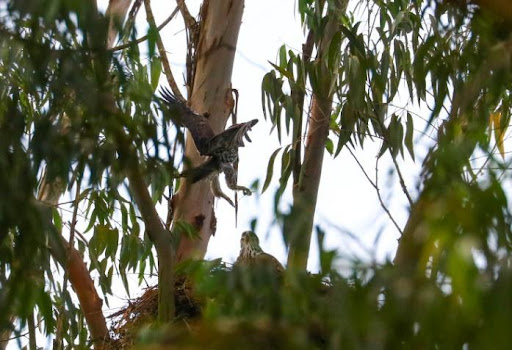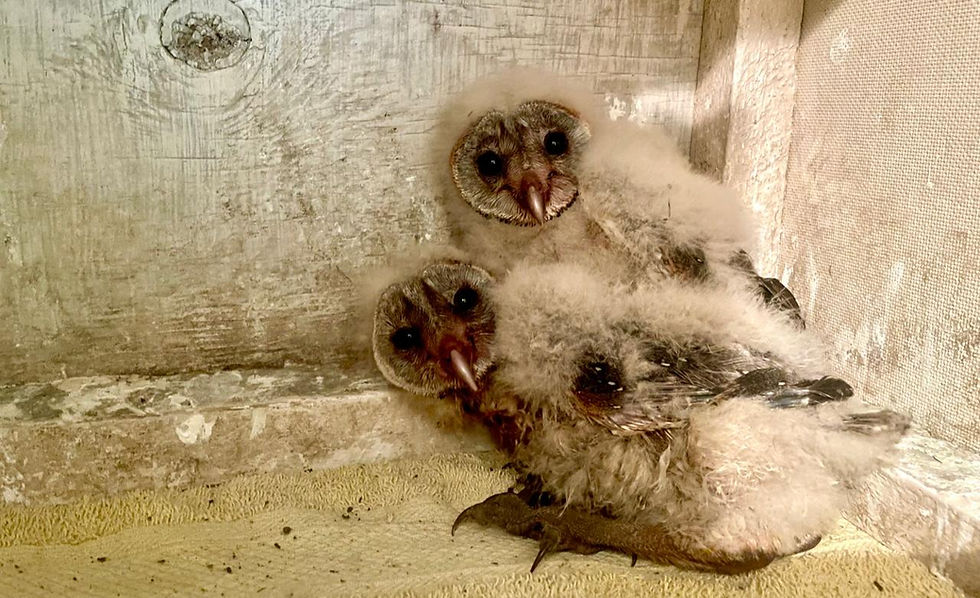The Ayres’s Hawk Eagle in suburbia
- Simon Thomsett

- Mar 21, 2022
- 4 min read
One morning I was shaving, looking out of the bathroom window, after a long trip from up-country to my parent’s place on the outskirts of Nairobi, getting ready for an important meeting. My eye rested on a Red-eyed Dove on top of a bare Jacaranda tree less than 50 m away. As I automatically focused crosshairs on it (for it looked so plump), it exploded in a cloud of feathers with an audible whack. Razor halfway to my chin, the Ayres’ flew off carrying it. I hadn’t even perceived its approach, and neither had the dove.
That important meeting was a job interview with Tom Cade, the President of the Peregrine Fund, and for want of something to do we left his wife with my parents and went to see what the neighbours had labeled as a “problematic Black Sparrowhawk that was a terror". Standing under the tall exotic eucalyptus tree looking at it lying flat on the nest it stared back with bright yellow eyes, not the dark red wine eyes of a Black Sparrowhawk. Tom called it first, an Ayres’s Eagle Hawk, and forever after reminded me of how I got it wrong, which I hadn't, but I still got the job!
The Ayres’s Hawk Eagle was no terror! They never descend to the ground to take chickens, but the owners of the tree didn’t discriminate, and to placate them we asked if a bevy of boffins could come and do all day watches. We did, and wrote a paper about it. In my previous blog I mentioned the terrible nesting success of the Ayres’s, and as predicted the nest suddenly leant to one side and threatened to hurl itself to the ground. I had to climb up and wire it safe. The chick fledged in front of all the top ornithologists of the day, only to have the recently fledged chick shot many times with an air gun by the landowner’s son! That young man had sat with us for weeks watching, but there was something sick within him. The next year they bred again, only to have a Tawny Eagle kill their chick. True enough, Ayres’s Hawk Eagles have a tough time surviving.
The shot just fledged chick 1986.
The Ayres’s was at one time confined to indigenous trees, and it is no coincidence that the first study pairs were in indigenous trees, as were the Black Sparrowhawk’s (in Ololua Forest in a croton tree and studied by Brown in 1960-70s). Then suddenly (around the mid to late 1970s) both species “discovered'' eucalyptus gum trees, and what appeared to be raptor rarities restricted to indigenous habitats (Brown termed the Black Sparrowhawk “Rare and elusive”), became, as Neil Baker once quipped “garden birds”. The term meme has been taken over to mean something very different in the social media world but in short it’s a behaviour that spreads in a manner analogous to biological evolution. A meme may do this, not just as a memory handed down but through more subtle processes of variation, mutation and inheritance, each of which influences a meme’s reproductive success. There’s a growing implication that memes are separable entities from the species that use them and that’s creepy and certainly not what I imply for a new habit learned by hawks, imprinted upon their young and thus handed on. But in this case the proposition is that overnight a new idea sprang into the minds of the Ayres’s Hawk Eagle and the Black Sparrowhawk to use exotic eucalyptus over indigenous trees. (It had been dawning on Long-crested and Wahlberg’s eagles too). It had been discovered before in Kenya, but it had been unusual. It may have been invented much earlier in South Africa, but it hadn’t spread. It brings an interesting management opinion to mind in deliberately changing the culturally ingrained use of indigenous landscapes and trees for many raptors, e.g.hacking out Red-breasted Sparrowhawks in lower, drier human dominated landscapes where there are gum trees and poplar plantations, but that’s a bigger story!
It's hard to say what is the preferred habitat of the Ayres’s Hawk Eagle, because they pitch up unexpectedly in the middle of pristine forests, city gardens, sandy beaches, garden ponds, pineapple plantations (where Darcy Ogada has a pair nesting), university campuses (where Washington Wachira took photos), and hunting over water holes in dry areas like Finch Hatton’s, Shompole, Lerata near Ololokwe). Its occurrence in indigenous forests such as the Ngurumans, Mathew’s, Aberdares, Cheranganis and Mt Kenya is to be expected. Its ability to adapt to human landscapes, especially its use of eucalyptus trees may make this the least likely eagle species to be extirpated in Kenya, though remaining at very low numbers.
To call it 'species recovery’ is an exaggeration, rather it was a three step forwards, two step backward lessening of a curve that was in free fall decline. It’s good news, but until people learn to live with raptors outside of elite gardens and arboretums and stop endless intrusion into indigenous forests, gum trees are not going to be their panacea. The Ayres’s Hawk Eagles are doing their best however, despite a fast changing landscape.
Ayres's Hawk Eagle visiting Nick Trent's bird pond in Kilifi.

The mixture of indigenous and exotic trees above typifies the modern “forest” of today with virtually no undergrowth and non terrestrial mammalian fauna. But in the eucalyptus is a nest of the Ayres’s Hawk Eagle. All it needs is a safe unclimbable tree (to humans, monkeys and small carnivores). This is a very illustrative photograph to which I am indebted to Washington Wachira.

An adult female Ayres’s Hawk Eagle over the Nguruman’s. This individual is paler than most females.
Photos of young in nest in a eucalyptus tree and adult female feeding in Thogoto-Kibiku Forest and Kenyatta University grounds, by Washington Wachira.
Photos by Darcy Ogada in Thika, again of an Ayres’s Hawk Eagle nest in a eucalyptus tree. Given the importance of mature “gum” trees in Kenya for raptors who now utilise them, the felling of old mature trees by County Councils in the name of ecologically conscious principles is yet another setback for raptors.




















Comments